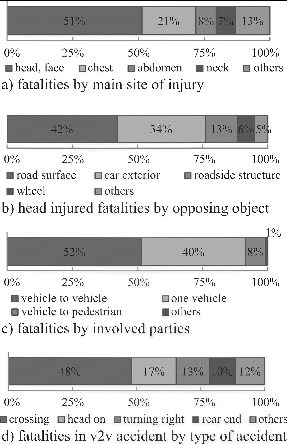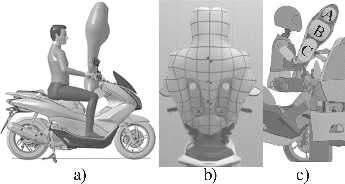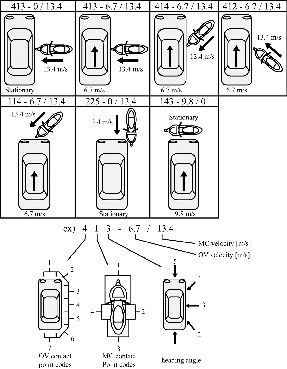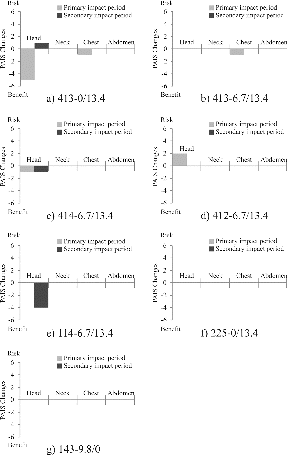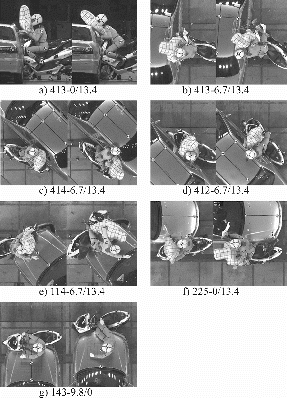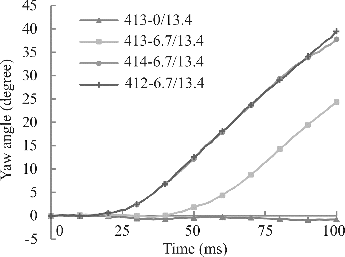Abstract
Objectives: An airbag system for motorcycle applications was developed and marketed in 2006 followed by many research projects on the system. In the airbag system, the bag should be supported during the kinetic energy–absorbing period of a rider in a collision. The previously developed system employed a configuration in which motorcycle structures support the airbag, such as a gauge unit and/or a steering structure. The supporting structure functions to receive the reaction force to hold the airbag during a crash to properly absorb the rider's kinetic energy. However, the previous system requires a larger area for this reaction structure and is applicable only to the motorcycles that can provide that area. To overcome this limitation, we propose an airbag system employing another concept. In this concept, the airbag does not use its vehicle structures as a reaction structure but uses the structures of an opposing vehicle, such as doors and/or pillars of an opposing vehicle. In this project, we aim to verify the effectiveness of the proposed system when installed in a motorcycle that cannot provide a larger area for the reaction structure.
Methods: In the system with this concept, it is assumed that the occupant protection performance is largely affected depending on impact configurations. Accordingly, full-scale motorcycle-to-car crash tests using 125 cm3 scooter-type models with and without the proposed system were conducted in various impact configurations. The 7 impact configurations specified in ISO 13232 were selected as the test configurations. Injury variables and injury indices of head, neck, chest, and abdomen were evaluated with the motorcyclist dummy.
Results: Injury variables and indices obtained from the crash tests with the airbag were compared to those of the baseline tests. In 2 impact configurations, the airbags were supported by the side structures of the opposing vehicle and performed to reduce the injury variable of head and/or chest compared to that of the baseline test.
Conclusion: Through the crash tests, beneficial protection effects of the airbag system were confirmed in particular impact configurations. No significant risk for the occupant due to the airbag was observed in the conducted crash tests. It was concluded that the proposed airbag system has feasibility to reduce rider injury in a collision of a motorcycle without sufficient reaction structure.
Introduction
According to the motorcyclist fatal accident statistics in Japan (Institute for Traffic Accident Research and Data Analysis n.d.), 64% of the fatal accidents occurred in frontal collisions. With this background, protection of a rider from frontal collision is essential.
An airbag system has been focused on as a protective device to reduce critical injuries of riders in frontal collisions in previous studies. A series of studies on an airbag system using a large touring model was successfully transferred into a practical application in 2006 (Kuroe et al. Citation2005). Kuroe et al. (Citation2004) also conducted research on an airbag system for a 600 cm3 scooter-type model to ascertain its feasibility.
An airbag generally requires structures to receive a reaction force (hereafter “reaction structure”) to hold the airbag during a vehicle crash to properly absorb the occupant's or rider's kinetic energy. In the case of a driver front airbag in a passenger car, the steering wheel serves as the reaction structure. Kuroe et al. (Citation2004, Citation2005) installed a motorcycle airbag behind the handlebar to make the structural parts of the motorcycle, such as the gauge unit and steering structures, serve as reaction structures. In the airbag system developed by Kanbe et al. (Citation2007), an airbag was installed at the front end of the rider seat of a 250 cm3 scooter-type model that restrained the rider in the lumbar area. In the system, a limb structure (called a back plate) was employed as a reaction structure. It was pulled up in front of the airbag by the airbag deployment force.
However, a sufficient reaction structure cannot be provided in some motorcycle models. For example, with the arrangement of an airbag behind the handlebar, an adequate reaction structure does not exist if the motorcycle is not equipped with an instrument panel and/or steering structure large enough for that function.
In view of the above, we propose an airbag system applicable to a motorcycle not having sufficient reaction structure. The concept of this airbag system is that the structures of the opposing vehicle, which the motorcycle is colliding, work as a reaction structure, rather than structures of the motorcycle itself.
In this article, the results of validation tests are described, together with the findings from the analyses on target configurations of impact, body regions to be protected, and prototype design. A scooter-type model without an adequate reaction structure was selected as the test motorcycle. A prototype airbag system was installed on that motorcycle. The crash tests were conducted in 7 impact configurations based on ISO 13232 (International Organization for Standardization [ISO] Citation2005, Citation2012). Research methods for making an overall evaluation of rider protection devices that are fitted to motorcycles are defined in the standard (see Appendix 1, online supplement). Each test was carried out using a motorcycle equipped with an airbag and one without. The effectiveness was evaluated by comparing the results.
Methodology
The aims of the proposed airbag system, the design of the prototype airbag, and the crash test method are described in this section.
Aims of Proposed Airbag System
The fatal accident statistics for Japan (Institute for Traffic Accident Research and Data Analysis n.d.) were analyzed to determine the target impact configurations.
More than half of fatalities were brought about by injuries to the head area ().
More than half of the head injuries were caused in collisions against opposing vehicles or roadside structures ().
Regarding patterns of fatal motorcycle crashes, more than half of the crashes were classified as vehicle-to-vehicle collisions (), and approximately half of those were crossing collisions ().
To reduce the number of fatalities in motorcycle crashes, we considered it effective to reduce head impact received from an opposing vehicle in crossing collisions. Crossing collisions include crashes into the side body of an opposing vehicle. Therefore, it was considered a feasible option to use the side of the opposing vehicle as a reaction structure. Accordingly, the goal for the proposed airbag system was set as reducing critical injuries by mitigating impact to head areas received from the opposing vehicle at the time of collision to the side of the opposing vehicle.
Design of Prototype Airbag
A scooter-type model and a sedan-type passenger car were selected as the test motorcycle and the opposing vehicle, respectively. The specifications are shown in Appendixes 2 and 3 (see online supplement).
and show the scooter-type model equipped with the prototype airbag system. The airbag module is located in the rear of the steering column. The surface around the gauge unit is not large enough to serve as an adequate reaction structure.
This airbag consists of 3 areas, and each area has a different function (). The topmost area A is intended to support the airbag by contacting the roof of the opposing vehicle. The center area B is intended to protect the rider's head and is thicker than other areas. The bottom area C is intended to hold the airbag in the upper direction and control the area B in appropriate position.
The airbag height is determined to contact the roof side of the opposing vehicle. The height depends on the location where the module is installed in the motorcycle. Taking into account the different moving directions of the rider and the motorcycle at the time of collision, the width of area B is set to a wider side. The airbag volume is approximately 80 L, and it has no vent holes. The folded airbag is stored in the retainer box along with the inflator. The specifications of the airbag are shown in Appendix 4 (see online supplement).
Crash Tests
The crash tests for validation of the airbag were conducted as per ISO 13232 (ISO 2005, 2012). shows 7 impact configurations required for crash tests.
Crash tests of motorcycles without airbags (baseline test) were tested prior to tests of motorcycles equipped with airbags (airbag test). A total of 14 crash tests were conducted.
Using measured impact on the motorcycle through the series of baseline tests, the airbag deployment timing was set for each airbag test. Though the airbag was set to not deploy in 143–9.8/0, in which the opposing vehicle collides into the side of the motorcycle, the airbag test was conducted without an airbag deployment to clarify the risk from the equipped airbag module.
To assess under severe conditions, the impact speed was set 4% higher than the speed specified in ISO 13232 (ISO 2005).
The motorcyclist anthropometric test device specified in ISO 13232 (ISO 2005, 2012) was used as the rider dummy. The 1990 revision of the Abbreviated Injury Scale (AIS; AAAM Citation1990) is used for assessment of motorcyclist injury in the standard. In this article, the probable AIS (PAIS) and the injury variables of head, neck, chest, and abdomen described in the standard are used for the assessment of motorcyclist injury (see Appendix 1).
Results
shows the PAIS of airbag tests in comparison with the baseline tests (all values of PAIS are shown in Appendix 5, see online supplement). The primary impact period is the time period until 0.500 s after the first contact of the motorcycle and the opposing vehicle. In that period, the rider interacts or hits the airbag and/or the opposing vehicle. The secondary impact period indicates the period from 0.500 s after the first contact, including the dummy-to-ground contact. The entire impact sequence is the period from 0.050 s before until 3.000 s after the first contact.
The result of each impact configuration is described below. The presence of interactions was judged from the trace of contact, high-speed photography, and the dummy measurements. Photographs of the 7 airbag tests are shown in .
413-0/13.4
The airbag deployed before the dummy touched the opposing vehicle. The upper body of the dummy, especially the head and the chest, was prevented from contact with the opposing vehicle. The head PAIS in the primary impact period was 0, compared to 5 for the baseline test. The chest PAIS was 0, compared to 1 for the baseline test. In addition, the head PAIS in the secondary impact period was 1, which was higher than in the baseline test. This injury occurred from contact with the ground.
413-6.7/13.4
The opposing vehicle yielded as a force in the lateral direction against the front of the motorcycle, causing the yaw motions of the motorcycle. Though the head contacted virtually the center of the airbag at the first contact, the position where the head contacted the airbag was off the center of the airbag due to the yaw motions of motorcycle. Eventually the head came off the airbag and contacted the upper end of the C pillar. Although the head PAIS in the entire impact sequence was 0 regardless of the airbag being equipped or not, the head injury criterion in the primary impact period was decreased from 350 (baseline test) to 72 (airbag test). In addition, the chest PAIS in the primary impact period was lower by 1 than the baseline test.
414-6.7/13.4
Yaw motion of the motorcycle occurred after the collision. The airbag moved aside from the traveling direction of the dummy due to the yaw motion of the motorcycle. Although the airbag prevented the upper right body from contacting the opposing vehicle, the head and the upper left body hit the C pillar. The head PAIS in the primary impact period and the secondary impact period was lower by 1 from the baseline test.
412-6.7/13.4
Yaw motion of the motorcycle occurred almost simultaneously with the collision. As the airbag moved aside due to the yaw motion, it completely came off the traveling direction of the dummy. There was almost no interaction between the dummy and the airbag, and the upper body impacted the opposing vehicle. The head PAIS in the primary impact increased from the baseline test.
114-6.7/13.4
Yaw motion of the motorcycle occurred after the collision. The airbag moved aside from the traveling direction of the dummy due to the yaw motion of the motorcycle. Although the airbag contacted half of the dummy body, because there was no reaction structure in front of the airbag, the airbag tilted forward without any resistance. The head PAIS in the secondary impact period was lowered by 4.
225-0/13.4
This was an offset collision on the front of the opposing vehicle. After the collision, the motorcycle and the dummy moved forward along the side of the opposing vehicle. Although the airbag was deployed, it had virtually no effect on the dummy. The PAIS for all body regions in the entire impact sequence was unchanged from the baseline. In both the airbag and the baseline tests, there were no serious injuries.
143-9.8/0
Because the collision was such that the passenger car collided with the side of the motorcycle, the airbag was not deployed. Even when compared to the baseline test, there was no significant change in the motion of the dummy. The PAIS for all body regions in the entire impact sequence was unchanged from the baseline.
Discussion
Validation of Protection Effect
Among the 7 impact configurations, 4 impact configurations (413-0/13.4, 413-6.7/13.4, 414-6.7/13.4, 412-6.7/13.4) are collisions on the side of the opposing vehicle, which are the target of the proposed airbag system. Described next is the head protection effect in the primary impact period of these configurations.
In 413-0/13.4:
The airbag prevented contact of the head on the opposing vehicle.
The head PAIS in the primary collision period was decreased from 5 to 0.
Because an injury was prevented, the head protection effect of the airbag was evident.
In 413-6.7/13.4:
The airbag being deployed between the head and the opposing vehicle.
The head injury criterion was decreased.
It can be judged that the airbag had a head protection effect.
In 414-6.7/13.4 and 412-6.7/13.4:
The airbag had almost no interaction with the head.
It can be judged that the airbag has no protection effect.
As described above, a head protection effect of the prototype airbag was observed in 2 of the 4 impact configurations on the side of the opposing vehicle. Especially in 413-0/13.4, a critical head injury was only observed in the baseline test. Therefore, we consider that the intended effect is attainable by the proposed concept of an airbag system.
The degrees of effectiveness of the airbag in the 4 impact configurations, in descending order of protection, were 413-0/13.4, 413-6.7/13.4, 414-6.7/13.4, and 412-6.7/13.4. This order corresponds to the magnitude of the yaw motion of the motorcycle after the collision, as shown in . This is because the yaw motion of the motorcycle moves the airbag laterally against the traveling direction of the dummy, which is moved by inertia, and reduces the overlap of the airbag and the dummy. Therefore, it can be stated that this yaw motion is a key factor of the protection effect of the proposed airbag system. The relationship between the yaw motion and the protection effect of an airbag was also addressed in a previous study (Kuroe et al. Citation2004).
It should be noted from the results of tests 114-6.7/13.4 and 225-0/13.4 that no protection effect is obtainable in the collision with the engine hood of the sedan-type car because there is nothing that holds the airbag.
Though it is not the body region subjected to protection, a lowering of chest PAIS was observed in 2 impact configurations (413-0/13.4, 413-6.7/13.4). That can be considered a protection effect from the reduction of impact by the airbag being deployed between the chest and the opposing vehicle or the parts around the handlebar. We therefore consider that this airbag system has a possibility to reduce chest injuries in the impact configurations with less yaw motion.
Risk Assessment
In the primary impact period of all airbag tests except 412-6.7/13.4, the PAIS for each body region was the same or lower than that of baseline tests. Hence, we consider that there is no significant risk due to installation of the proposed airbag system in these impact configurations. The head PAIS in 412-6.7/13.4 was higher than in the baseline test. Compared to the baseline test, the dummy head contact location on the opposing vehicle in the airbag test was slightly different. Judging from the high-speed photography, the airbag had almost no interaction with the dummy. A slight difference in the motion of the motorcycle after the collision was observed. It can be considered that the dummy motion was affected by the motorcycle motion. The motion was changed due to the difference in the center of gravity resulting from the installation of the airbag system. In view of the above, though it can be assumed that the result of 412-6.7/13.4 was not a direct effect of the airbag that increased injuries, it implies that risks due to installation of a protective device should be further analyzed through an overall evaluation in the future.
In the secondary impact period of all airbag tests except 413-0/13.4, the PAIS for each body region was the same or lower than that of baseline tests. The head PAIS in airbag test 413-0/13.4 indicates a minor injury, showing an increase from the baseline test. A possible reason is that the airbag affected the falling movement of the dummy. However, compared to the dummy movement in the baseline test, the airbag did not affect the dummy posture so that the dummy touched the ground on its head. It was not observed that the effect of the airbag on dummy movement increased the potential for serious head injury on contact with the ground. In view of the above, it is assumed that there is no risk due to installation of the proposed airbag system in the secondary impact period of all tested impact configurations.
Limitations
The findings presented are only from the 7 impact configurations. It is necessary to analyze the overall risks and benefits indicated in ISO 13232 (ISO 2005, 2012). The analysis can be conducted by computer simulation of 200 impact configurations.
Conclusion
In this article, the effectiveness of the airbag system based on a concept that uses the colliding vehicle as a reaction structure was evaluated as a feasibility study of an airbag system for motorcycles with no sufficient reaction structure.
Considering the frequency and the part of injury analyzed from the fatal accident statistics, the aim of the proposed airbag system was to reduce critical injuries by mitigating impact to the head received from the opposing vehicle in a crossing collision.
The head protection effect of the airbag was observed in the collision on the side of the opposing vehicle involving no or slight yaw motion of the motorcycle at the time of collision.
Within the tested impact configurations, no significant risk due to the proposed airbag system has been observed.
In view of the above, we conclude that this airbag system provides a certain level of protection effect. We therefore consider that the proposed airbag system has feasibility to reduce rider injury from a collision involving a motorcycle with no sufficient reaction structure.
Supplemental Materials
Supplemental data for this article can be accessed on the publisher's website
Appendix
Download Zip (337.3 KB)References
- Association for the Advancement of Automotive Medicine. The Abbreviated Injury Scale. Des Plaines, Illinois: Author; 1990.
- Institute for Traffic Accident Research and Data Analysis. Traffic Accident Data, 1997–2011. Tokyo, Japan: Author; n.d.
- International Organization for Standardization. Motorcycles—Test and Analysis Procedures for Research Evaluation of Rider Crash Protective Devices Fitted to Motorcycles, Parts 1 to 8. 2nd ed. Geneva, Switzerland: International Organization for Standardization; 2005. International Standard ISO 13232,
- International Organization for Standardization. Amendment 1, Motorcycles—Test and Analysis Procedures for Research Evaluation of Rider Crash Protective Devices Fitted to Motorcycles, Parts 1 to 8. 2nd ed. Geneva, Switzerland: Author; 2012. International Standard ISO 13232.
- Kanbe S, Deguchi M, Hannya Y. Basic research for a new airbag system for motorcycle. Paper presented at: 20th International Technical Conference on the Enhanced Safety of Vehicles (ESV); June 18–21, 2007; Lyon, France.
- Kuroe T, Iijima S, Namiki H. Exploratory study of an airbag for a large scooter-type motorcycle. Paper presented at: 5th International Motorcycle Conference (IFZ)2004; Munich, Germany.
- Kuroe T, Namiki H, Iijima S. Exploratory study of an airbag concept for a large touring motorcycle: further research second report. Paper presented at: 19th International Technical Conference on the Enhanced Safety of Vehicles (ESV); June 6–9, 2005; Washington, DC.

